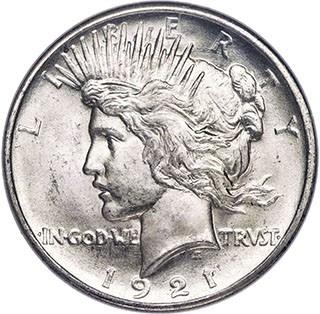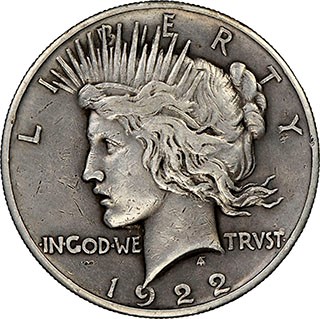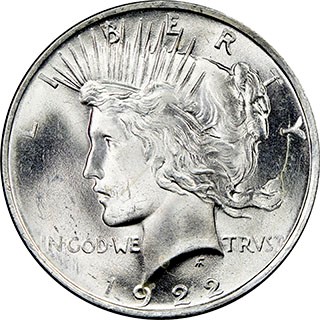Fifth 1922 Modified High Relief Peace Dollar Pattern Discovered and Certified by NGC
Posted on 6/8/2021
When David Lange, Research Director at Numismatic Guaranty Corporation® (NGC®), identified the first 1922 Modified High Relief Peace Dollar in 2001, very little was known about these coins. Even though they look dramatically different from regular-issue 1922 Peace Dollars, it still took 80 years for the first example to be found and properly cataloged. Now, 20 years later, new research reveals their full history, and a fifth example has been discovered.
The story of the 1922 Modified High Relief Peace Dollar is straightforward enough. The 1921 Peace Dollar was produced in high relief during its first year of issue, which had a relatively low mintage. But it was impractical to produce at a much higher mintrage.
The US Mint could realize as many as 200,000 coins from a pair of dies when striking the 1921 Morgan Dollar, which had conventional low relief. In contrast, many die pairs for the 1921 High Relief Peace Dollar failed before 25,000 coins had been struck. To prolong die life, lower pressure was used, resulting in softly struck coins with incomplete central detail, a common trait seen on 1921 Peace Dollars.
Initially, plans were to continue to produce high relief coins in 1922. George Morgan, Chief Engraver at the US Mint, created dies for the new year and production began at Philadelphia. The same problems quickly surfaced, production was halted and all coins struck were ordered to be melted. The Proof 1922 High Relief Peace Dollars, however, come from this production.
Morgan then experimented with a Modified High Relief version in an attempt to correct the die life and striking deficiencies encountered with the 1921 issue. Morgan repositioned the date, strengthened the legends and subtly reworked Liberty’s hair. Detailed research conducted by Roger Burdette revealed that his work focused primarily on the obverse.
Once these new dies were prepared, 3,200 examples were struck, including a sandblast (or matte) Proof, a satin Proof and regular-issue coins. The Proofs and the final coin struck were delivered to Mint Director Raymond T. Baker.
 |
|
| Mint Director Raymond Baker and coin designer Anthony de Francisci. (Library of Congress image) Click images to enlarge. |
|
Ultimately, this experiment failed to produce the desired results. Baker then re-engaged Anthony de Francisci, the coin’s original designer, to reduce the relief more extensively. The result was the low relief Peace Dollar produced from 1922 through 1935.
But what became of Morgan’s 3,200 experimental Modified High Relief coins struck in January 1922?
The answer comes in part from coins from Director Baker’s own estate, which surfaced in 2014. Included were both the satin Proof example and the 3,200th example struck that had been delivered to him for review. Coins from Morgan’s experiment did survive!
Novel research quickly followed. The 1922 Modified High Relief Peace Dollar was assigned the catalog number J-2020 in the standard reference, United States Pattern Coins. Further retrospective study revealed that a matte Proof 1922 Peace Dollar sold by Bowers & Merena in September 1985 was not the type of 1921, but in fact the Modified High Relief example, and perhaps the piece sent to Baker. It also became clear that the coin certified by NGC in 2001 and graded AU 55 was from this group of 3,200, bringing the total known to four examples.
Were any other of the 3,200 examples struck released among the 51,737,000 low relief Peace Dollars coined at Philadelphia in 1922? Yes! A fifth example from these dies — the third circulation-issue example — has now been certified by NGC and graded AU 50.
The coin was submitted to NGC by Aaron Muller of Muller Rare Coins of Hamburg, Pennsylvania, primarily a bullion dealership serving wholesale accounts on the East Coast. The unusual coin was spotted by Jared Coller, President of Operations, while sorting circulated dollars acquired in bulk. They have no immediate plans for the coin.
“As we celebrate the centennial of the Peace Dollar this year, it’s gratifying how aspects of this coinage are still very relevant and alive to researchers and collectors alike,” said Scott Schechter, NGC Chief Numismatist and Grading Finalizer. “Perhaps what is most exciting is that we suspect more of these fascinating coins are waiting to be found. A veritable treasure hunt is underway.”
Stay Informed
Want news like this delivered to your inbox once a month? Subscribe to the free NGC eNewsletter today!




